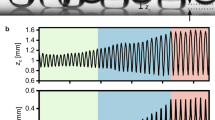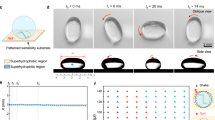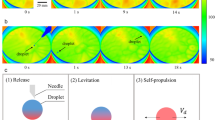Abstract
As discovered by Leidenfrost, liquids placed on very hot solids levitate on a cushion of their own vapour1,2,3. These model hovercrafts are remarkably mobile: placed on a hot ratchet, a droplet not only levitates, but also self-propels, in a well-defined direction, at a well-defined velocity4 (typically, 10 cm s−1). The challenge is to understand the origin of the phenomenon, which contrasts with other situations where an asymmetry in the solid/liquid contact was used to generate liquid self-propulsion5,6,7,8,9,10,11,12,13,14,15. We consider Leidenfrost solids that directly sublimate on hot substrates, and show that they also self-propel on ratchets. This leads to a scenario for the motion: the vapour flow escaping below the Leidenfrost body gets rectified by the presence of asymmetric textures, so that a directional thrust drives the levitating material. Using fishing lines to catch drops, we measure the force acting on them, and discuss both the driving force and the special friction generated by the textures.
This is a preview of subscription content, access via your institution
Access options
Subscribe to this journal
Receive 12 print issues and online access
$259.00 per year
only $21.58 per issue
Buy this article
- Purchase on SpringerLink
- Instant access to full article PDF
Prices may be subject to local taxes which are calculated during checkout




Similar content being viewed by others
References
Leidenfrost, J. G. De Aquae Communis Nonnullis Qualitatibus Tractatus (Duisburg, 1756).
Gottfried, B. S., Lee, C. J. & Bell, K. J. Leidenfrost phenomenon—film boiling of liquid droplets on a flat plate. Int. J. Heat Mass Trans. 9, 1167–1172 (1966).
Biance, A. L., Clanet, C. & Quéré, D. Leidenfrost drops. Phys. Fluids 15, 1632–1637 (2003).
Linke, H. et al. Self-propelled Leidenfrost droplets. Phys. Rev. Lett. 96, 154502 (2006).
Chaudhury, M. K. & Whitesides, G. M. How to make water run uphill. Science 256, 1539–1541 (1992).
Bain, C. D., Burnett-Hall, G. D. & Montgomerie, R. R. Rapid motion of liquid drops. Nature 372, 414–415 (1994).
Domingues Dos Santos, F. & Ondarçuhu, T. Free-running droplets. Phys. Rev. Lett. 75, 2972–2975 (1995).
Sumino, Y., Magome, N., Hamada, T. & Yoshikawa, K. Self-running droplets: Emergence of regular motion from nonequilibrium noise. Phys. Rev. Lett. 94, 068301 (2005).
Daniel, S., Chaudhury, M. K. & Chen, J. C. Past drop movements resulting from the phase change on a gradient surface. Science 291, 633–636 (2001).
Brochard, F. Motions of droplets on solid surfaces induced by chemical or thermal gradients. Langmuir 5, 432–438 (1989).
De Gennes, P. G. The dynamics of reactive wetting on solid surfaces. Physica A 249, 196–205 (1998).
Bico, J. & Quéré, D. Self-propelling slugs. J. Fluid Mech. 467, 101–127 (2002).
Buguin, A., Talini, L. & Silberzan, P. Ratchet-like topological structures for the control of microdrops. Appl. Phys. A 75, 207–212 (2002).
John, K., Hänggi, P. & Thiele, U. Ratchet-driven fluid transport in bounded two-layer films of immiscible liquids. Soft Matter 4, 1183–1195 (2008).
Prakash, M., Quéré, D. & Bush, J. W. M. Surface tension transport of prey by feeding shorebirds: The capillary ratchet. Science 320, 931–934 (2008).
Daniel, S. & Chaudhury, M. K. Rectified motion of liquid drops on gradient surfaces induced by vibration. Langmuir 18, 3404–3407 (2002).
Shastry, A., Case, M. J. & Böhringer, K. F. Directing droplets using microstructured surfaces. Langmuir 22, 6161–6167 (2006).
Daniel, S., Chaudhury, M. K. & de Gennes, P. G. Vibration-actuated drop motion on surfaces for batch microfluidic processes. Langmuir 21, 4240–4248 (2005).
Tong, L. S. Boiling Heat Transfer and Two- Phase Flow (Taylor & Francis, 1997).
Snezhko, A., Ben Jacob, E. & Aranson, I. S. Pulsating-gliding transition in the dynamics of levitating liquid nitrogen droplets. New J. Phys. 10, 043034 (2008).
Nagy, P. T. & Neitzel, G. P. Optical levitation and transport of microdroplets: Proof of concept. Phys. Fluids 20, 101703 (2008).
Lorenceau, E., Quéré, D., Ollitrault, J. Y. & Clanet, C. Gravitational oscillations of a column in a pipe. Phys. Fluids 14, 1985–1992 (2002).
Biswas, G., Breuer, M. & Durst, F. Back-facing step flows for various expansions at low and moderate Reynolds numbers. J. Fluids Eng. 126, 362–374 (2004).
Wachters, L. H. J., Bonne, H. & van Nouhuis, H. J. The heat transfer from a horizontal plate to sessile water drops in the spheroidal state. Chem. Eng. Sci. 21, 923–930 (1966).
Acknowledgements
We thank A-L. Biance, E. Lorenceau, L. Tobin, H. Turlier, H. Rathgen, A. Le Goff, G. Dupeux and H. Wagret for stimulating discussions, and L. Quartier and D. Renard for designing the ratchets.
Author information
Authors and Affiliations
Contributions
G.L., M.L.M., C.C. and D.Q. designed the experiments; G.L. and M.L.M. carried out the experiments; G.L., M.L.M., C.C. and D.Q. developed the models; C.C. and D.Q. wrote the manuscript. G.L. and M.L.M. equally contributed to the work?
Corresponding author
Ethics declarations
Competing interests
The authors declare no competing financial interests.
Rights and permissions
About this article
Cite this article
Lagubeau, G., Le Merrer, M., Clanet, C. et al. Leidenfrost on a ratchet. Nature Phys 7, 395–398 (2011). https://doi.org/10.1038/nphys1925
Received:
Accepted:
Published:
Issue date:
DOI: https://doi.org/10.1038/nphys1925
This article is cited by
-
Flexible hemline-shaped microfibers for liquid transport
Nature Chemical Engineering (2024)
-
Probing surface wetting across multiple force, length and time scales
Communications Physics (2023)
-
Tailoring vapor film beneath a Leidenfrost drop
Nature Communications (2023)
-
Motion of Leidenfrost self-propelled droplets on ratchet in low- and high-temperature regimes
Journal of Mechanical Science and Technology (2023)
-
Interfacial friction at action: Interactions, regulation, and applications
Friction (2023)



